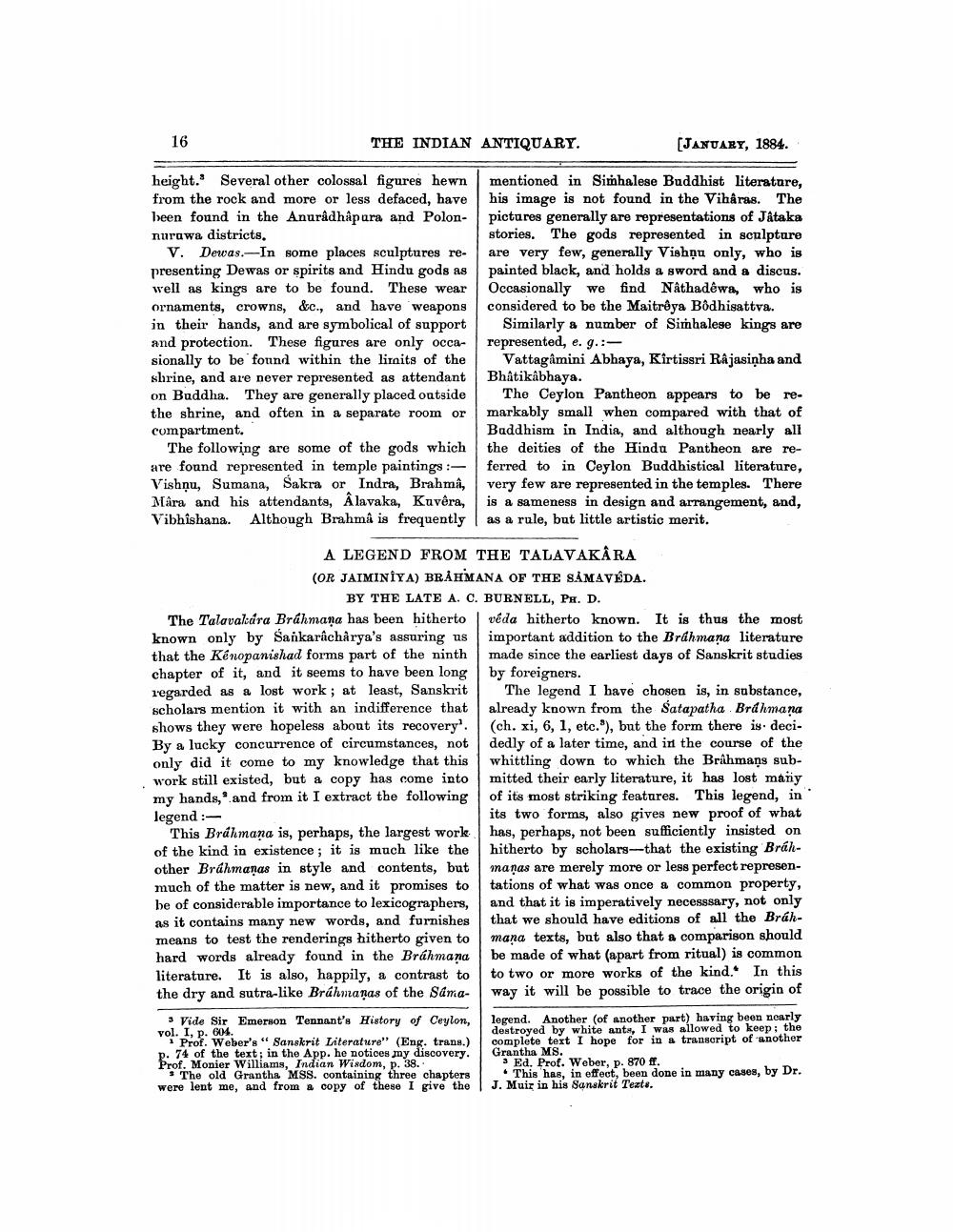________________
16
THE INDIAN ANTIQUARY.
(JANUARY, 1884.
height. Several other colossal figures hewn mentioned in Sinhalese Buddhist literature, from the rock and more or less defaced, have his image is not found in the Viharas. The been found in the Anuradhapura and Polon- pictures generally are representations of J&taka nurawa districts.
stories. The gods represented in sculpture V. Dewas.-In some places sculptures re- are very few, generally Vishņu only, who is presenting Dewas or spirits and Hindu gods as painted black, and holds a sword and a discus. well as kings are to be found. These wear Occasionally we find Nathadéwa, who is ornaments, crowns, &c., and have weapons considered to be the Maitreya Bodhisattva. in their hands, and are symbolical of support Similarly a number of Simhalese kings are and protection. These figures are only occa- represented, e. g. :sionally to be found within the limits of the Vattagamini Abhaya, Kirtissri Rajasinha and shrine, and are never represented as attendant
Bhatikabhaya. on Buddha. They are generally placed outside The Ceylon Pantheon appears to be rethe shrine, and often in a separate room ormarkably small when compared with that of compartment.
Buddhism in India, and although nearly all The following are some of the gods which the deities of the Hindu Pantheon are reare found represented in temple paintings :- ferred to in Ceylon Buddhistical literature, Vishņu, Sumana, Sakra or Indra, Brahma, very few are represented in the temples. There Mára and his attendants, Alavaka, Kuvera, is a sameness in design and arrangement, and, Vibhishana. Although Brahmå is frequently as a rule, but little artistic merit.
A LEGEND FROM THE TALAVAKARA (OR JAIMINİYA) BRÅHMANA OF THE SAMAVÉDA.
BY THE LATE A. C. BURNELL, PH.D. The Talavakára Brahmana has been hitherto | veda hitherto known. It is thus the most known only by Sankaracharya's assuring as important addition to the Brahmana literature that the Kénopanishad forms part of the ninth | made since the earliest days of Sanskrit studies chapter of it, and it seems to have been long by foreigners. regarded as a lost work; at least, Sanskrit The legend I have chosen is, in substance, scholars mention it with an indifference that already known from the Satapatha Brahmana shows they were hopeless about its recovery'. (ch. xi, 6, 1, etc.), but the form there is deciBy a lucky concurrence of circumstances, not dedly of a later time, and in the course of the only did it come to my knowledge that this whittling down to which the Brahmans subwork still existed, but a copy has come into mitted their early literature, it has lost maiiy my hands, and from it I extract the following of its most striking features. This legend, in legend :
its two forms, also gives new proof of what This Brahmana is, perhaps, the largest work has, perhaps, not been sufficiently insisted on of the kind in existence; it is much like the hitherto by scholars--that the existing Bráhother Brahmanas in style and contents, but maņas are merely more or less perfect represenmuch of the matter is new, and it promises to tations of what was once a common property, be of considerable importance to lexicographers, and that it is imperatively necessary, not only as it contains many new words, and furnishes that we should have editions of all the Bráhmeans to test the renderings hitherto given to mana texts, but also that a comparison should hard words already found in the Brahmana be made of what (apart from ritual) is common literature. It is also, happily, a contrast to to two or more works of the kind. In this the dry and sutra-like Bráhmaņas of the Sama- way it will be possible to trace the origin of
Vide Sir Emerson Tennant's History of Ceylon, legend. Another (of another part) having been nearly vol. I, p. 604.
destroyed by white ante, I was allowed to keep : the Prof. Weber's" Sanskrit Literature" (Eng. trane.) complete text I hope for in a transcript of another p. 74 of the text: in the App. he notices my discovery. Grantha MS. Prof. Monier Williams, Indian Wisdom, p. 38.
Ed. Prof. Weber, p. 870 ff. 3 The old Grantha MSS. containing three chapters • This has, in effect, been done in many cases, by Dr. were lent me, and from a copy of these I give the J. Muir in his Sanskrit Texte.




